Archive:Consolidated supply, use and input-output tables
- Data extracted in October 2015. Most recent data: Further Eurostat information, Main tables and Database. Planned update of the article: September 2016.
A comparison of the EU and the United States economies
This article presents the latest available European consolidated supply, use and input-output tables for 2010, 2011 and 2012 in terms of the NACE Rev. 2 classification, together with some practical and methodological background information. For the first time, the tables are disseminated under the new ESA 2010 methodology.
The consolidated supply, use and input-output tables are used for macro-analysis of the European Union (EU) and euro area (EA) economies. They give an annual snapshot of overall production and use of products, distinguishing 64 NACE activities and 64 products from the CPA classification. The US data were compiled by Eurostat using the same classifications.
The data are broken down into 10 activities and 10 product groups.
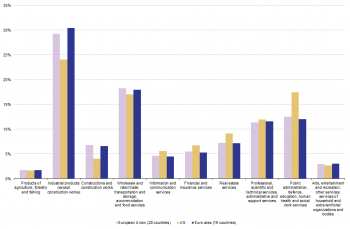
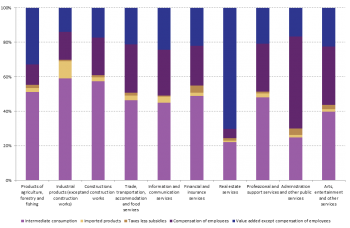
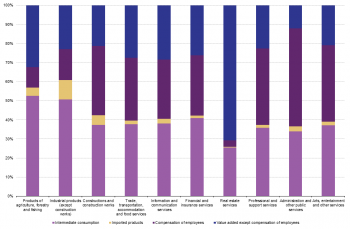
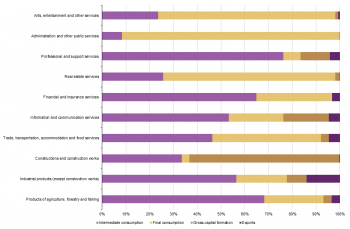
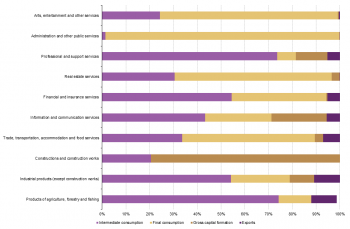
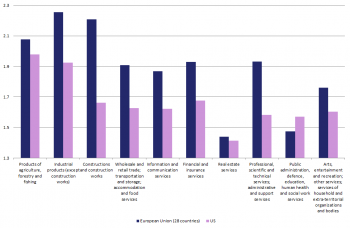

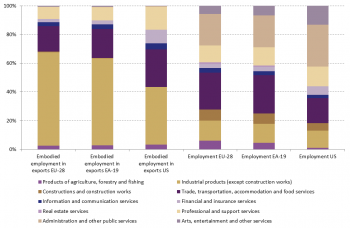
Main statistical findings
In 2012, the EU was more oriented towards industry, construction and trade than the US economy. Industrial products and trade services represent 29 % and 18 % respectively of total EU output (see Figure 1). In the United States, industrial products represent 24 % of total output, followed by trade services and administration services with 17 %. The euro area has the same dominant groups as the EU, with industrial products and trade services (wholesale and retail trade, transportation and storage, accommodation and food services) accounting for 30 % and 18 % respectively of total output. Construction works is a significant area of industrial output in both the EU and the United States, with 7 % and 4 % respectively. In all cases, agricultural products represent a very low proportion of total output (2 % in 2012).
The US economy is more oriented towards services and public administration than the EU’s
Figure 1 shows that, unlike the EU economy, the US economy is more geared to services than industry, construction and trade. All services account for 33 % of total output in the United States, but only 29 % in the EU (28 % for the EA). Financial services (including insurance and real-estate services) represent 16 % of total output in the United States, a higher proportion than in the EU (12 %). In 2012, 17 % of US output came from public administration services (including defence, education, human health and social work services), while the EU figure was 13 %.
Different cost structures in the EU and the United States
Intermediate consumption represents the most costly input in the EU economy, while labour input dominates in the US economy. The input-output (I-O) tables show the production structures of the EU and US economies. The columns in the tables represent the cost structure of the industry and the rows the composition of its revenues. The value added is the difference between output and intermediate consumption. The I-O tables for 2012 highlight some differences between the two economies (see Figures 2 and 3): except for agricultural products and public administration services, input from value added is more important for the United States than for the EU. As regards industrial products, value added makes up 30 % of the total for the EU, as against 39 % for the United States. In trade services and accommodation services, value added accounts for 49 % of total output in the EU but 60 % in the United States. For agricultural products, the proportion represented by value added is comparable in the two economies: 45 % in the EU and 43 % in the United States. For public administration services, value added is less in the United States than in the EU as a proportion of output (64 % as against 70 %).
Labour input (measured in terms of compensation of employees) largely balances out the lower cost of intermediate consumption for the United States: construction works, trade services, information and communication services and professional and support services require more expenditure on salaries than in the EU. Labour input accounts for 36 % of total construction costs in the United States, as compared with 22 % in the EU, and 33 % in trade services, as against 28 % in the EU. In information and communication services, the figures are 31 % for the United States and 27 % for the EU.
In real-estate services, the components of value added excluding compensation of employees are equivalent to 71 % of total output in the United States and a similar proportion in the EU.
Intermediate consumption
As regards the composition of revenues, the EU uses a greater proportion of its products for intermediate consumption than the United States. In Figures 4 and 5, the first bar on the left shows intermediate consumption as a proportion of total uses. For all product groups except agricultural products and real-estate services, the proportion is higher in the EU than in the United States. For both economies, the highest proportion (around 75 %) relates to professional and support services. Proportions for final consumption are comparable between the EU and the United States, except for agricultural products and trade, transportation, accommodation and food services. 25 % of the EU’s agricultural production is for final consumption and only 4 % for exports, while 14 % of US agricultural production is for final consumption and 11 % for exports. The other product group for which there are differences is trade, transportation, accommodation and food services, where 46 % of EU output goes to final consumption, while in the United States the proportion is 56 %.
Impact of final demand on the EU and US economies
Output multipliers reflect the direct and indirect requirements of domestic production per unit of final demand. One additional unit of final demand for agricultural products would generate around two units of revenue/output in both the United States and the EU (Figure 6). In the EU, the biggest output multiplier is for industrial products, where one additional unit of final demand would create 2.3 units of output (1.9 in the United States in 2012). Output multipliers are generally higher in the EU than in the United States, i.e. the European economy would produce more than the US economy in response to an increase of one unit of final demand. The one exception is public administration, defence, education and health services, where the multiplier for the United States (1.6) is slightly larger than the EU’s (1.5).
Embodied employment in exports in the EU, the euro area and the United States
Embodied employment in exports represent the number of persons employed by the firms that are directly engaged in exporting activities (direct effects) including also those used by upstream industries for the supply of the necessary inputs to these firms (indirect effects).
In 2012, the total number of persons employed by firms engaged in export activities (directly and indirectly) went down by 10 % in the EU and rose by 11.6 % in the euro area as compared with 2010. In the United States, such employment increased by 15 %. Embodied employment in exports represents 11 % of total employment in the EU, 18 % in the euro area and 6 % in the United States (see Fig 7).
In 2012, the production of manufactured products for export accounted for an average of 65 % of embodied employment in EU, 61 % in EA and 40 % in US exports (see Fig 8). Services in the trade, transport, accommodation and food, and information and communication sectors accounted for 18 % of the total number of persons employed by firms engaged in export activities in the EU, 20 % in the EA and 26 % in the United States.
Data sources and availability
On the basis of the European I-O tables, a standard input-output technique was used to calculate the results of the Leontief quantity model applied to employment. First, a domestic input coefficient matrix (A) was calculated for each homogeneous branch of activity, showing direct input requirements for the production of one unit of output. Then the Leontief inverse matrix (the inverse of I — A, being I, the identity matrix) was computed to obtain the matrix of output multipliers. Next, the inverse matrix was post-multiplied by a column vector of exports to calculate the total output embodied in those exports. Finally, output coefficients of employment pre-multiplied the former results to obtain the figure for employment embodied in exports.
Embodied employment in exports: number of persons employed by firms directly engaged in export activities (direct effects), including those employed by upstream industries for the supply of the necessary inputs (indirect effects);
For the first time, Eurostat has compiled supply and use tables for the EU, the euro area and the US ( BEA) using the new ESA 2010 methodology. All statistics relating to national accounts are now developed in this new methodological framework, which is the European adaptation of the 2008 System of National Accounts. The make table, use table at producers values from the BEA are used alongside the benchmark table for the year 2007.
Context
The data are collected under the European System of National and Regional Accounts (ESA 2010) transmission programme. EU Member States transmit supply and use tables (SUTs) to Eurostat annually and input-output tables (IOTs) every five years, up to 36 months after the end of the reference period.
The SUTs give detailed information on production processes, interdependencies in production, the use of goods and services, and income generated in production. They form the basis for symmetrical IOTs, which are produced by applying certain assumptions to the relationship between outputs and inputs and are used by policy-makers for input-output analysis.
Environmentally extended (EE) IOTs, an extension in Eurostat, represent another powerful analytical instrument to inform policy.
Eurostat has compiled consolidated European tables for the EU-28 and the EA in ESA 2010 from reference year 2010.
See also
- Building the System of National Accounts - supply and use tables (chapter of online publication Building the System of National Accounts)
- National accounts and GDP
- Supply and use tables - input-output analysis (background article)
Further Eurostat information
Publications
- European exports 2000-2007: direct and indirect effects on employment and labour income in the EU 27 and euro area - Statistics in focus 36/2012
- CO2 emissions induced by EU's final use of products are estimated to be 9 tonnes per capita - Statistics in focus 22/2011
Database
- Supply, use and Input-output tables (naio_10_cp)
Dedicated section
Methodology / Metadata
- Eurostat Manual of Supply, Use and Input-Output Tables
- Methodological information on the compilation of the US supply and use tables in European classications, September 2013
- Methodological information on the consolidated European tables for years 2008 and 2009
- Technical Documentation eeSUIOT project
Other information
External links